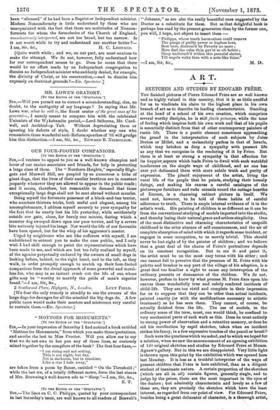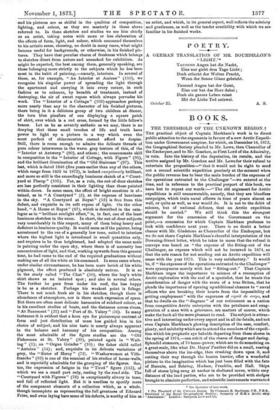ART.
SKETCHES AND STUDIES BY EDOTJARD FRERE. THE finished pictures of Pierre Edouard Frere are so well known+ and so highly valued in this country, that it is as little needful for us to vindicate his claim to the highest place in his OWLIt branch of art as to describe its leading characteristics. Standing at the head of a school of his own creation, which comprises several worthy disciples, he is still facile princeps, while the tone of feeling which inspires both his own work and that of his pupils is essentially distinct from that of other contemporary painters of rustic life. There is a poetic element sometimes approaching the grand in the interpretation of such subjects by Jules Breton or Millet, and a melancholy pathos in that of Israels, which may betoken as deep a sympathy with peasant life. as any that we recognise in the rendering of it by Frere. But there is at least as strong a sympathy in that affection for its happier,aspects which leads Frere to dwell with such watchfuli tenderness on the simple ways of childhood, and no one has ever yet delineated them with more subtle truth and purity of expression. The placid enjoyment of the artist, living the rural life of the people that he paints, studying their homely doings, and making his canvas a careful catalogue of the. picturesque furniture and rude utensils round the cottage hearths of Ecouen, is a charming cabinet picture in itself. We need not, however, to be told of these habits of careful adherence to truth. There is ample internal evidence of it in the artist's work. His painting of children is as different as it can be from the conventional studying of models imported into the studio, and thereby losing their natural grace and artless simplicity. One of the most distinctive and charming characteristics of unspoilt childhood is the utter absence of self-consciousness, and the air of complete absorption of mind with which it regards some incident, or engages in some occupation, to us merely trivial. This should never be lost sight of by the painter of children ; and we believe- that a great deal of the charm of Frere's portraiture depends on its constant recognition. But to see it and paint it, the artist must be on the most easy terms with his sitter ; and one cannot fail to perceive that the presence of M. Frere with hie. palette and brushes in any part of the village of his adoption, is a, great deal too familiar a sight to cause any interruption of the, ordinary pursuits or demeanour of the children. We do not, however, profess to know by what process M. Frere fixes upon his- canvas these wonderfully true and subtly rendered incidents of child-life. They are too vivid and complete in their impression, for us to suppose that they can be other than actual incidents, painted exactly (or with the modifications necessary to artistic- treatment) as he has seen them. They cannot, of course, be- actually finished from the life. The use of models, in the ordinary sense of the term, must, one would think, be confined to very mechanical parts of such work as this. Does he trust entirely to strong power of observation and a retentive memory, or does he- aid his recollection by rapid sketches, taken when an incident strikes his fancy, in a few expressive touches of the pencil or brush?'
Such were the questions which we asked, and to which we hoped for a solution, when we saw the announcement of an opening exhibition, of 120 original sketches and studies by Edouard Frere at Messrs. Agnew's gallery. But in this we are disappointed. Very little light is thrown upon this point by the exhibition which was opened here last Monday. It is less as a truthful interpreter of the ways of peasant children that Frere is here exhibited, than as a diligent student of inanimate nature. A certain proportion of the sketches (which are all in oil) contain figures, generally single, and to judge by the prices, these are the most important in the eyes of the dealers ; but admirably characteristic and lovely as a few of these are, they are precisely the sketches which have the least interest, as regarded from our point of view. For Edouard Frere, besides being a great delineator of character, is a thorough artist, and his pictures are as skilful in the qualities of composition, lighting, and colour, as they are masterly in those above referred to. In these sketches and studies we see him chiefly as an artist, taking notes with more or less elaboration of the effects of form, light, and colour, which commend themselves to his artistic sense, choosing, no doubt in many cases, what might become useful for backgrounds, or otherwise, in his finished pic- tures. They have that peculiar charm of freshness which belongs to sketches direct from nature and uncooked for exhibition. As might be expected, the best among them, generally speaking, are those belonging more strictly to the subjects which he has been most in the habit of painting,—namely, interiors. In several of these, as, for example, "An Interior at Amiens" (110), we recognise his singular power of spreading the light through the apartment and carrying it into every corner, in such fashion as to enhance, by breadth of treatment, instead of destroying, the air of sweet repose which always pervades his work. The "Interior of a Cottage" (103) approaches perhaps more nearly than any to the character of his finished pictures, there being in it a delicious group of two children at dinner, the torn blue pinafore of one displaying a square patch of shirt, over which is a red cross, formed by the little fellow's braces. Let us be as severely ..sthetic as we may, there is no denying that these small touches of life and truth have power to light up a picture in a way which even the most perfect of chiaroscurists cannot afford to despise. Still, there is room enough to admire the delicate threads of pure colour interwoven in the warm grey texture of this, of the "Interior at Antwerp" (90), and others ; the consummate skill in composition in the "Interior of Cottage, with Figure" (95), and the brilliant illumination of the "Old Staircase "(97). This last, which is dated 1848 (five years earlier than any of the others, which range from 1853 to 1872), is indeed exceptionally brilliant, and more so still is the exceedingly luminous sketch of a "Court- yard at Piseop " (105). For, as a rule, the out-of-door sketches are leas perfectly consistent in their lighting than those painted within-doors. In some cases, the effect of bright sunshine is ob- tained, as in "A Courtyard" (2), at the expense of heaviness in the sky. "A Courtyard at Royat " (13) is free from this defect, and exquisite in its soft repose of light. On the other band, "A House at Royat " (67), which is described in the cata- logue as in "brilliant sunlight effect," is, in fact, one of the least luminous sketches in the room. In short, the out-of-door subjects vary considerably in this respect, many of them being heavy and deficient in luminous quality. It would seem as if the painter, being accustomed to the use of a generally low tone, suited to interiors where the highest light is introduced in small quantities only, and requires to be thus heightened, had adopted the same scale in painting under the open sky, where there is of necessity less concentration of light, and that, working upwards from this general tone, he had come to the end of the required graduations without making use of all the white at his command. In some cases where, under similar circumstances, he has been more lavish of his white
pigment, the effect produced is absolutely untrue. It is so in the study called "The Chat" (50), where the boy's white shirt shows as an isolated spot ; and also in several others. The further he goes from under his roof, the less happy is he as a sketcher. Perhaps his weakest point is foliage. There is not much fresh air in his sketches, though there is abundance of atmosphere, nor is there much expression of space. But there are often most delicate harmonies of subdued colour, as in his excellent studies of boats, and the distances across rivers, "At Beaumont" (21) and "Port of St. Valery " (56). In many instances it is evident that a keen eye for picturesque contrast of form and just distribution of mass has guided him in his choice of subject, and his nice taste is nearly always apparent in the balance and harmony of his composition. Among the most admirable of the figure studies are the "Old Fisherman at St. Valery " (39), painted again in " Wait- ing" (1); an "Organ Grinder" (10) ; the fisher child called " Antoine " (54); and, exquisite in its delicate variations of grey, the "Sister of Mercy" (72). "Washerwomen at Ville- franche " (82) is one of the sunniest of his studies of house-walls, and is especially admirable for the grouping of the figures. See, too, the expression of fatigue in the "Tired" figure (115), of which we see a small part only, resting by the road side. The "Courtyard with Figures" (76) is exceptionally silvery in tone, and full of reflected light. But it is needless to specify more of the component elements of a collection which, as a whole, though incomplete as representing the full greatness of Edouard Frere, and even laying bare some of his defects, is worthy of him as an artist, and which, in its general aspect, well reflects the sobriety and gentleness, as well as the tender sensibility with which we are familiar in his finished works.



































 Previous page
Previous page